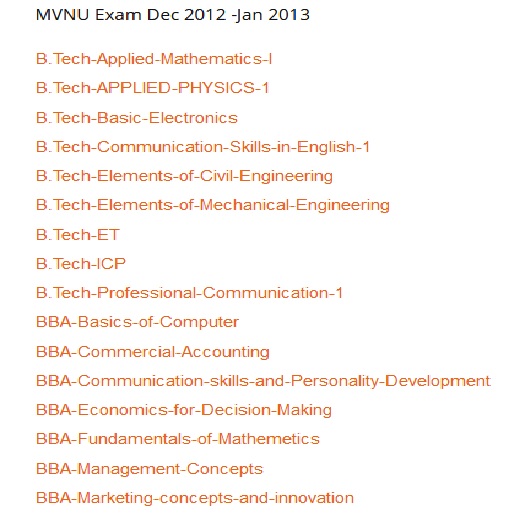MVN MEL101 Elements of Mechanical Engineering B.Tech Previous Year Question Paper
Name of the College : MVN University
Department : Mechanical Engineering
Subject Code/Name : MEL-101-Elements of Mechanical Engineering
Year : Dec.2012 – Jan.2013
Degree : B.Tech
Sem : I
Website : mvn.edu.in
Document Type : Previous Year Question Paper
Download Model Question Paper : https://www.pdfquestion.in/uploads/mvn.edu.in/3093-Elements-of-Mechanical-Engineering.pdf
MVN Elements of Mechanical Engineering Previous Question Paper
Time Allowed: 03 hours.
Maximum Marks: 100
Related : MVN University CEL101 Elements of Civil Engineering B.Tech Question Paper : www.pdfquestion.in/3091.html
Instructions
Before answering the question paper the candidate should ensure that they have been supplied the correct question paper. Complaints in this regard, if any, shall not be entertained after the examination.
Note: Attempt any five questions and all questions carry equal marks.

January 2014
Section – A :
1(a) How much heat must be supplied to 1.5 kg of a gas to raise its temperature from 90ºC to 225ºC at constant pressure?Find also the external work done during the supply of heat, specific heat at constant pressure is 1 KJ/KgK and at constant volume is 0.7128 KJ/KgK.
(b)Explain artificial draught & natural draught & what are the advantages of artificial draught over natural draught?
2(a) Sketch and briefly describe the volute and diffusion type centrifugal pump. What function is served by volute chamber in a centrifugal pump?
(b) Sketch stress-strain diagram for ductile material and explain its salient features. How does stress-strain curve for brittle materials differ from this curve?
3(a) Explain double & triple start worm & worm wheel in detail?
(b)What is a dynamometer &Explain belt transmission dynamometer in detail?
Section – B :
4(a) Explain different types of accidents & what are the different causes of accident?
(b)What is the principle of working of a milling machine? Differentiate between conventional and climb milling.
5(a) What is an allowance & Describe different types of allowances given on pattern?
(b) Mention the causes and remedies of the following sand casting defects: blow holes, hot tears, misruns.
6. What is an arc welding process? Describe briefly the power source, technique & flux materials used in TIG welding process.
June 2013
Engineering Thermodynamics
Subject Code: MEL-211
Time Allowed: 03 hours.
Maximum Marks: 100
Note :
Before answering the question paper the candidate should ensure that they have been supplied the correct question paper.
Complaints in this regard, if any, shall not be entertained after the examination.
Question No. 1 is Compulsory and attempt two questions from each section. All questions carry equal marks.
Section A :
1(a) Describe State, Path, Process and Cycle.
(b) State difference between extensive, intensive and specific properties of thermodynamic system.
(c)Explain the first law of Thermodynamics referred to closed system undergoing a cyclic change.
(d) What are the limitations of first law of thermodynamics .
(e) What do you understand by reversible and irreversible processes? Give example of both processes. (5*4=20)
2(a) Explain reversible, irreversible and quasi-static processes with suitable examples. (10)
(b) An automobile vehicle of 2000 kg is running at a speed of 72 km/hr. The brakes are applied and vehicle is brought to rest. Calculate the rise in temperature of brakes. If the mass of brake is 18 kg, specific heat of brake material = 0.46 kg /kg K. (10)
3(a) Derive the expression for steady Flow Energy Equation . State the assumption made before the derivation. (10)
(b) When a stationary mass of gas was compressed without friction at a constant pressure, its initial state of 0.4 m3 and 0.105 MPa was found to change to a final state of 0.20 m3 and 0.105 MPa. There was a transfer of a 42.05 KJ of heat from the gas during the process. How much did the internal energy of gas changes. (10)
4. Prove that Kelvin Plank and Clausius statement of second law of thermodynamics are equivalent. (20)
Section-B :
5. (a) Explain Helmholtz and Gibbs function (10)
(b) 500 kg iron block is initially at 2000C and is allowed to cool to 270C by transferring heat to the surroundings. Determine the available and unavailable engines. Specific heat of Iron = 0.45 KJ/Kg K. (10)
6. (a) What do you understand by tiple point and critical point. What is the difference of these two points? (10)
(b) Steam enters at a pressure of 10 bar and 250°C. It is exhausted at 0.2 bar. Steam at Exaust is 0.9 dry. Find Drop and change in enthalpy. (10)
7. (a)with the help of neat sketch explain the working of two stroke SI engine. (10)
(b) Explain the terms and their importance w.r.t IC engines
(i) IHP (ii) BHP (iii) FHP (10)